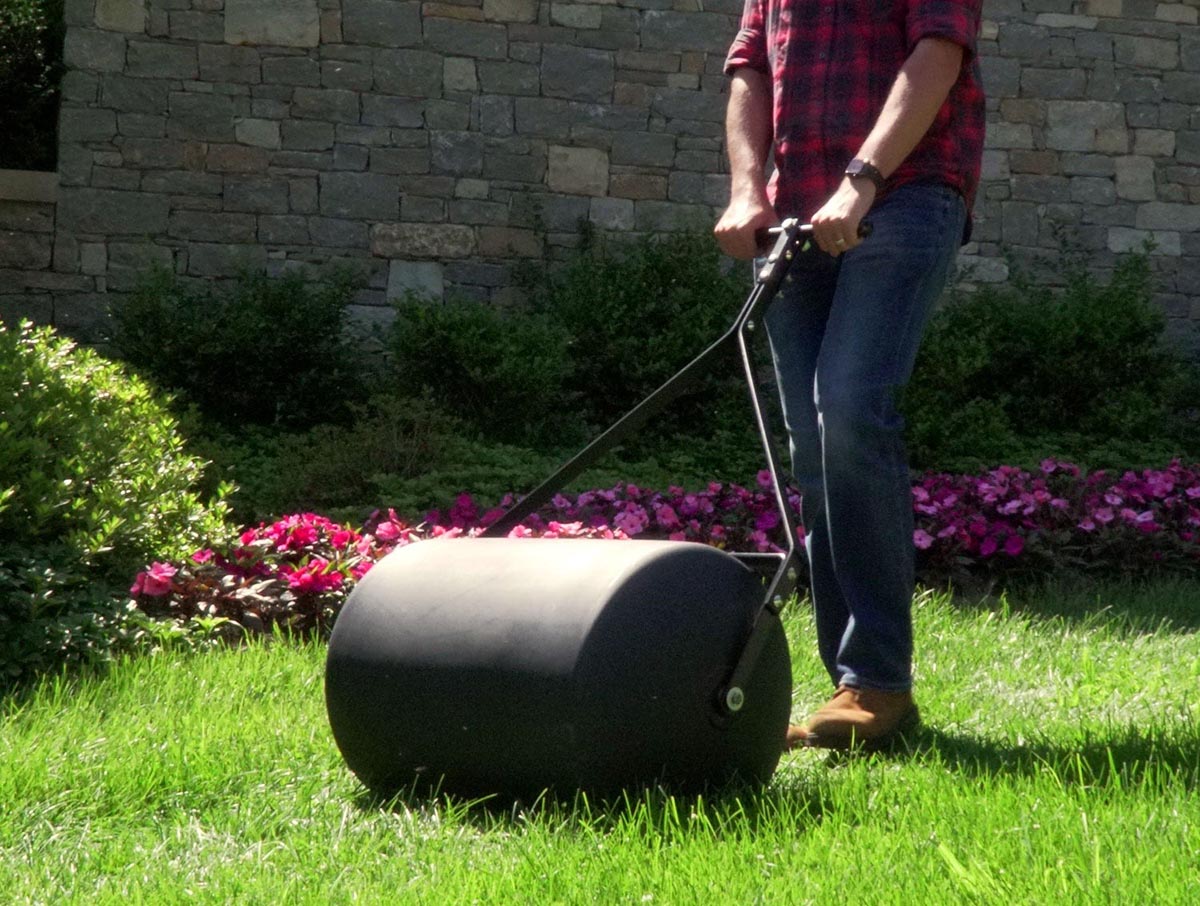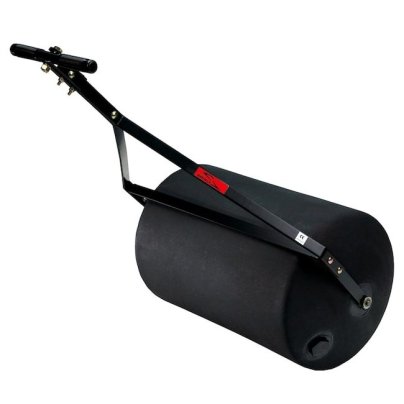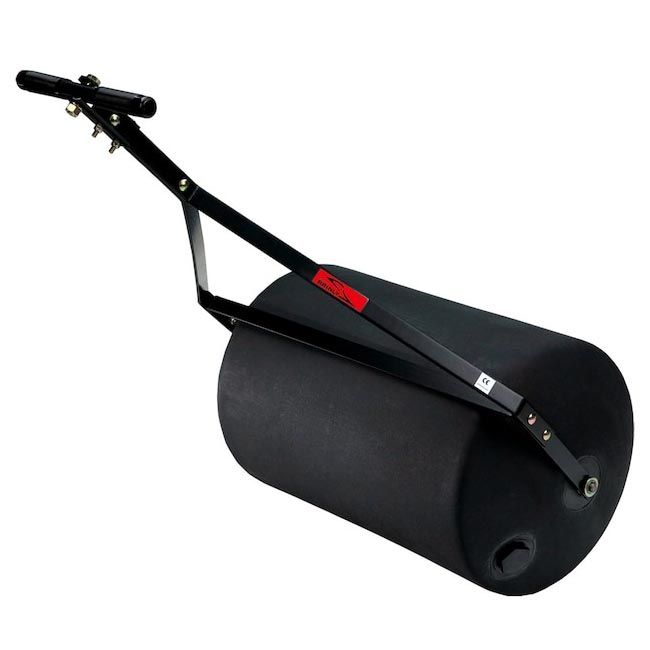
We may earn revenue from the products available on this page and participate in affiliate programs. Learn More ›
Lawn rollers have a simple job: to compact or smooth out a lawn area. Michael Clarke, horticulturist and founder of Yardwork, sums up the tool as “a large, heavy drum that can be filled with water or sand and pushed or pulled across your lawn to flatten or smooth out the surface of your yard.” These heavy-weight tools are most useful for smoothing soil before seeding grass or laying sod, improving contact between the seed or sod and soil, and for flattening a lawn after minor upsets.
For example, Clarke explains, “Homeowners living in colder climates would benefit from having a lawn roller, since the freeze-thaw cycle can cause soil to shift or rise. A light rolling in early spring will help reset the lawn without damaging it.” A grass roller can also help flatten mole or ant hills. But they come with a few caveats.
For many households, a lawn roller is not a necessary tool for lawn care, so it’s important to determine if you really need one before shopping. Rolling a lawn unnecessarily can compress the soil too much, which prevents water and nutrient absorption. For really bumpy lawns, there are other ways to level a yard. It’s possible to rent a lawn roller or hire a lawn rolling service if you only need to use it once for laying sod. But if you’ll use it more often, shop the best lawn rollers ahead.
Best Overall
Brinly PRC-242BH Push/Tow Poly Lawn Roller
Buy at The Home Depot Buy at Lowe's Buy at The Tractor Supply CoWhat We Like
- Option to push or tow
- Rounded drum edges prevent lawn damage
- Extra-large opening for faster filling and emptying
What We Don’t Like
- A few reviewers report faulty products with leaks
Specs
- Type: Push or tow
- Material: Plastic drum, steel frame
- Maximum weight: 270 pounds
Brinly-Hardy has been in business for well over a century and has an excellent reputation for building quality lawn equipment. The Brinly PRC-242BH Push/Tow Poly Lawn Roller is no exception. It’s a heavy-duty lawn mower with a plastic drum and a durable steel frame. Thanks to its robust design, it’s suitable as a manual push tool for typical home lawns as well as a tow-behind attachment on a tractor for larger areas.
The 28-gallon polyethylene drum holds up to 270 pounds of water or sand. It has rounded edges, so it won’t leave marks or damage on your lawn when turning. It also has a large-diameter opening that allows it to be filled and emptied faster. When empty, the lawn roller is lightweight and easy to store.
Get the Brinly lawn roller at Lowe’s, The Home Depot, Tractor Supply Co., or Brinly.
More Lawn Rollers Worth Your Money
If the Brinly PRC-242BH Push/Tow Lawn Roller doesn’t feel just right for your needs, there are other excellent products on the market. The following list includes more budget-friendly picks and heavier, tractor-pulled options that might better suit your yard.
- Einhell GC-GR 57 Garden Roller, available at Amazon.
- Goplus Lawn Roller, available at Amazon or Goplus.
- Brinly PRT-36BH Tow-Behind Poly Lawn Roller, available at Amazon or Tractor Supply Co.
- Agri-Fab 45-0604 Tow Behind Poly Lawn Roller, available at Amazon or Tractor Supply Co.
- Ohio Steel Professional Grade Steel Lawn Roller, available at The Home Depot or Tractor Supply Co.
How We Chose the Best Lawn Rollers
We conducted in-depth research on some of the most popular products on the market to narrow down our top picks. The best lawn rollers on our list are highly rated, many coming from the most-trusted brands in this field. Most also include extra features that improve user experience, such as dirt wipers or extra-large openings for filling and emptying.
We considered the roller material, including a mix of metal and plastic lawn rollers (plastic tends to be cheaper, lighter, and may appeal more to the average homeowner). We also included rollers with varying maximum weights to suit different users. Both manual push and tractor-pulled lawn rollers found a place on our list.
FAQs
Unlike dethatching or mowing (consider the best reel mowers or lawn mowers for this job), lawn roller landscaping isn’t necessary for every lawn. In fact, using one incorrectly can cause more harm than good—so it’s prudent to do your research before buying one. Here are some questions you might have about using this tool.
Lawn rollers are just one method that can be used to level a yard, but they are effective. Lawn rollers can smooth out minor bumps from frost heaves or mole hills. You can also use a roller for ground compaction and to improve contact between seed or sod and soil.
It depends on your reason for rolling—there isn’t a specific month for this task. Use a roller as part of the grass-starting process when it’s suitable to seed or sow in your area. If trying to smooth out a lawn after frost heaves, use a lawn roller when winter is over.
Hand rollers for lawns on the smaller side can be pushed over any lumps and bumps. However, for larger lawns and plots of land that are more uneven, it’s best to tow (or pull) the roller by attaching it to a tractor or mower. Combining a lawn mower with a heavy roller can be a great system for lawn striping.
Just heavy enough to get the job done; you don’t want to compress your lawn too much. First, use the lawn roller filled with water or sand ⅓ or ½-full and see if it works well enough for the task. Residential rollers for home gardeners tend to max out at around 250 pounds in weight.
Yes, you can fill the lawn roller with water or sand.
Not necessarily. When to aerate depends on the grass type. This might not coincide with when you lawn roll. It’s possible to buy aerator lawn roller products (they’re essentially a lawn roller with spikes), but these did not have good reviews in our research. Consider using a regular lawn aerator instead.


